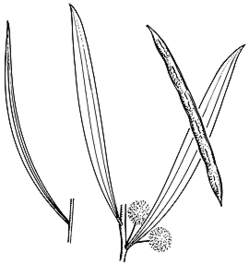Common name: varnish wattle
Acacia verniciflua A.Cunn. APNI* Synonyms: Racosperma vernicifluum (A.Cunn.) Pedley APNI*
Acacia verniciflua var. pendula Seem. APNI*
Acacia virgata Lodd., G.Lodd. & W.Lodd., nom. inval., nom. nud. APNI*

Description: Erect or spreading shrub or tree 1–4 m high, single- or multi-stemmed, the main branches slender and erect or pendulous; bark grey, smooth but may become rough/finely fissured on older trunks; branchlets terete or slightly angled, often zig-zagged, usually resinous/viscid, usually glabrous. The branchlets are normally marked with broad (0.5–1 mm wide), ± flat or scarely raised, yellow or green longitudinal bands that sometimes age brown in dry material and sometimes have a very narrow (<0.5 mm wide), raised vein along their mid-line while the regions between the bands are often dark red-brown and filled with resin which may be elevated above the bands to form a discontinuous or crenulated 'resin rib' (Maslin & Murphy 2009).
Phyllodes variable in shape and size, elliptic to very narrowly elliptic, sometimes lanceolate or narrowly oblong to oblong-oblanceolate, straight or slightly curved, sometimes shallowly sigmoid, 2–9 cm long, (1.5-) 3–15 (-25) mm wide, usually shiny or viscid-resinous, glabrous or sparsely appressed-hairy on main veins and margins, dotted with resin glands, 2 longitudinal veins visible with the lower (± central) one often more prominent (the upper vein is sometimes poorly developed), lateral veins superficially absent or obscure, anastomosing to form an open reticulum; apex acute or rarely obtuse and with a mucro; 1–4 small glands along margin; pulvinus to 1.5 mm long.
Inflorescences simple, 1–3 per axil or 2–6-headed racemes with axes to 2 mm (-5) mm long; peduncles 3–15 mm long, glabrous to appressed-hairy; heads globose, 30–60-flowered, 5–12 mm diam., yellow to bright yellow.
Pods straight to strongly curved, raised over seeds, ± straight-sided to barely constricted between seeds, sometimes more deeply constricted between some seeds, 2.5–10 cm long, 3–6 mm wide, firmly papery to thinly leathery, glabrous, resinous; seeds longitudinal; funicle filiform.
Flowering: August–November.
Distribution and occurrence: widespread south of Tamworth. Grows chiefly in dry sclerophyll forest on the ranges and Slopes, often along rocky streams or on skeletal ridges.
NSW subdivisions: ?CC, CT, NT, ST, NWS, CWS, SWS, SWP
Other Australian states: Qld Vic. S.A.
Very variable species. There are specimens with narrow, prominently curved phyllodes which may appear 1-veined because of the second vein being poorly developed. Acacia leprosa var. graveolens looks similar to Acacia verniciflua in having 2-veined phyllodes, however the species differ most noticeably in branchlet features. The name 'verniciflua' means flowering with resinous material, referring to the viscid phyllodes having a varnished appearance, which is more noticeable in fresh material than dried specimens.
Text by P.G. Kodela (April 2009).
Taxon concept: B.R. Maslin & D.J. Murphy (Muelleria 27: 183-223, 2009)
APNI* Provides a link to the Australian Plant Name Index (hosted by the Australian National Botanic Gardens) for comprehensive bibliographic data
***The AVH map option provides a detailed interactive Australia wide distribution map drawn from collections held by all major Australian herbaria participating in the Australian Virtual Herbarium project.
|


